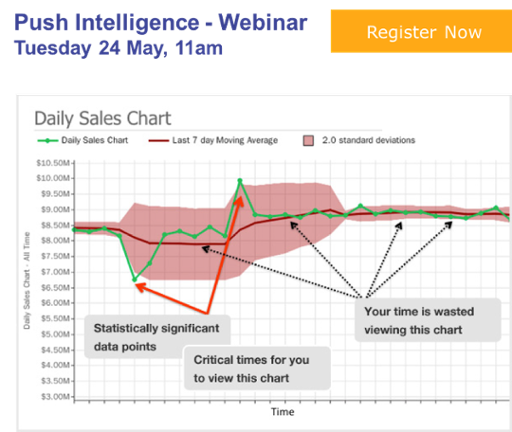Many organizations have implemented Business Intelligence (BI) tools in the hopes of making their operations data-driven and therefore more effective. Yet, despite the investment of millions in BI tools, the technology has under delivered on its promise. As noted by Gartner and many other analysts, user adoption of BI tools remains poor. Push Intelligence is the new approach to Business Intelligence that enables the business analyst to better support the needs of the business user. Rather than requiring business users to crawl through dashboards to find relevant changes, Push Intelligence proactively alerts users to important changes in the key performance indicators (KPI’s) that they care about.

How is Push Intelligence Different to Business Intelligence (BI)?
A decade or two ago, the average BI expert had less data to work with on a less frequent basis. In-house data warehouses stored a finite amount of structured data, which was crunched on a monthly basis and delivered to users across the business.
With everything from smartphones to industrial sensors spewing both structured and unstructured data, no one can keep up, let alone get ahead of the barrage of data. BI has become a reactive job, instead of an exploratory one. At the end of the day, the average BI employee simply reacts to requests, making more and more dashboards in hopes of zeroing in on what business users might ask next.
The reality is that data has become too big and too frequent for humans to make sense of. Every organization aspires to be metrics driven, but it requires machines to do the heavy lifting to determine what’s important.
3 Key Differences Between Push Intelligence & BI
Push Intelligence builds on an organization’s existing investments in data and Business Intelligence, but uses a fundamentally different architecture and approach to delivering insights. It automatically analyzes every detailed metric within an organization to determine which are important now, why they are important, and who needs to know about them.
There are 3 major components to Push Intelligence that make it different to the dashboard and report approach.
#1 Change
BI tools focus on the values for metrics — what was Sales in Belgium today? Push Intelligence snapshots metric values over time and applies algorithms to the data to analyze how values are changing. It does this automatically for every dimensional value, of every metric.
#2 Relevance
BI tools display all the metrics all the time, via dashboards and reports. Push Intelligence analyzes how metrics are changing to determine which are relevant and actionable now, and bubbles them up to the surface.
#3 Distribution
BI tools rely on users to pull the information they need, when they need it. Push Intelligence determines who needs to know about the relevant changes in metrics, when they need to know, and where. It uses a distribution engine that tells users only the information that they need to know about, at the relevant frequency, and on the right device.
Business Intelligence tools provide analysts with a powerful platform for performing data discovery. The power of Push Intelligence is required to ensure you are not missing critical events in your data, by enabling users to focus on what’s important and become metrics-driven.
(Source: Mike Smitheman, Metric Insights)



